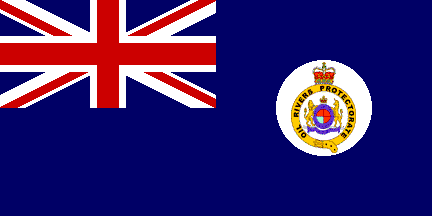
Last modified: 2014-07-05 by bruce berry
Keywords: nigeria | oil rivers protectorate | niger coast protectorate | blue ensign |
Links: FOTW homepage |
search |
disclaimer and copyright |
write us |
mirrors
 image by Jaume
Ollé, 06 Feb 2000
image by Jaume
Ollé, 06 Feb 2000
See also:
The Oil Rivers Protectorate was established in 1884 in the Niger delta in
what is modern day Nigeria. The area was called the "oil rivers"
because it was once a major producer of palm oil. British sovereignty over
the area was confirmed at the Berlin Conference in 1885 and on 12 May 1893 the
protectorate was enlarged and
re-named the Niger Coast Protectorate. In 1900 this enlarged protectorate was
amalgamated with the southern part of the territory that had been administered
by the Royal Niger Company to form the Colony and Protectorate of
Southern
Nigeria.
David Prothero, 04 Feb 2000
Oil Rivers Protectorate ensign
It is assumed that the Oil Rivers Protectorate flew a defaced British blue ensign with the badge of the protectorate in the fly. This was the pattern adopted by the other protectorates in the area. However, I have my doubts about this flag. The area in the centre is the Royal Arms. I think it unlikely that the badge was ever used on a Blue Ensign or a Union Jack.
The problem is that the Oil Rivers Protectorate and the
Niger Coast
Protectorate were administered by the British Foreign Office and not
transferred to the Colonial Office until 1899. Any Oil Rivers flags would
have been of a consular nature. According to Van Steenbergen ,the flag
of the consul at Creektown, Old Calabar in 1860, was a White Ensign with K
in the upper fly, E in the lower hoist and H in the lower fly. In 1891 the
consul at Old Calabar was replaced by a Commissioner and a consul-general.
David Prothero, 04 Feb 2000